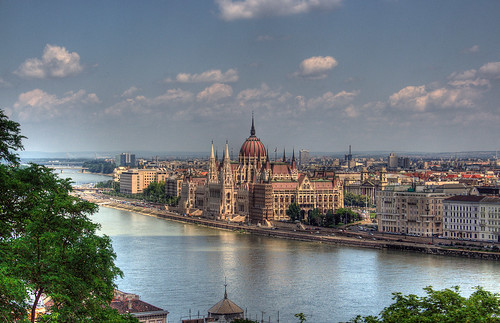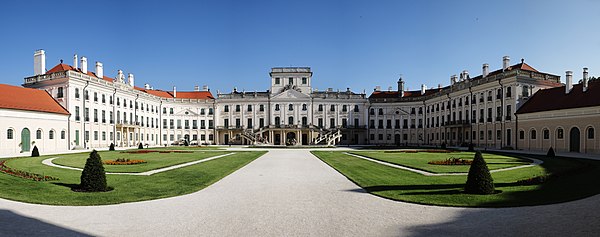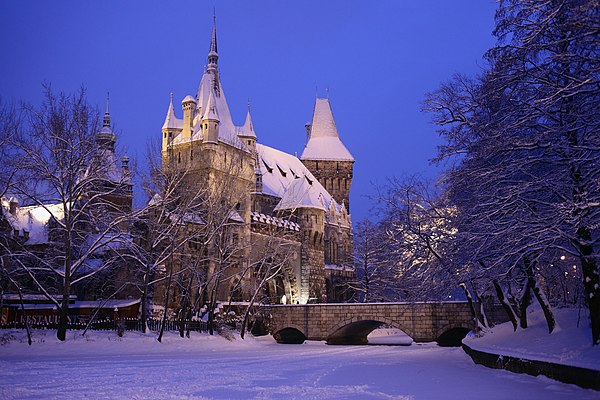

Introduction
Hungary doesn't need neon flash - it's a natural show-stopper. Hungary is a heart-stealer; it will lure you back again and again to sample its rich wines, lounge in its thermal spas, gaze at its birdlife and make one more attempt to master its hermetic language.
It has all the luxury of western Europe with a Magyar twist and at half the cost.
 Its graceful capital Budapest has a lively arts, cafe and music scene, and is host to a range of cultural and sporting festivals. In the countryside you'll find majestic plains, resort-lined lakes, Baroque towns, horse markets and rustic villages.
Its graceful capital Budapest has a lively arts, cafe and music scene, and is host to a range of cultural and sporting festivals. In the countryside you'll find majestic plains, resort-lined lakes, Baroque towns, horse markets and rustic villages.
 Geography:
Geography:
Hungary is a kidney-shaped country lying in the centre of Europe; it shares borders with seven neighbours: Austria, Slovakia, Ukraine, Romania, Serbia, Croatia and Slovenia. There are three basic topographies: the low-lying regions of the Great Plain in the east, centre and southeast, and the Little Plain in the northwest; the northern mountain ranges, which include Hungary's highest peak (the 1015m/3330ft-high K é kestet ő ); and the hilly regions of Transdanubia in the west and south-west. The biggest rivers are the Danube and the Tisza, which divide the country into thirds, and the Dr á va, which forms the southwestern border with Croatia. The country has over 1000 lakes - the largest, Balaton, is strewn with thermal springs.
 Destination Facts
Destination Facts
Capital: Budapest
President: L á szl ó S ó lyom
Prime Minister: Ferenc Gyurcsany
Government: parliamentary democracy
Time zone: GMT +1
Area: 92966
Population: 10083000
People: 92% Magyar, 4% Roma, 2.6% German, 0.8% Slovak, 0.7% Romanian, other
Languages: Hungarian (Magyar) is a member of the Ugric group of the Uralic family of languages.
68% Roman Catholic, 21% Reformed (Calvinist) Protestant, 6% Evangelical (Lutheran), 5% other
Currency: Forint (Ft)
Major industries: Mining, metallurgy, agriculture, construction materials, processed foods, textiles,chemicals (especially pharmaceuticals) and motor vehicles
Major Trading Partners: Germany, Austria, Italy, Russia
Daylight Saving: From last Sunday in March to last Sunday in October
Country Dialing Code: 36
 Getting there and away
Getting there and away
Mal é v Hungarian Airlines, the national carrier, flies direct to Budapest from the USA and more than 30 European countries. It also has Mediterranean services to/from Cairo, Larnaca and Tel Aviv. Hungary is connected to all of its seven neighbouring countries by road and rail. Vol á nbusz runs regular transport services to about 18 different European countries, while Magyar Á llamvasutak (M Á V) has express rail services that run as far as London, Stockholm, St Petersburg, Istanbul and Rome. Motorists can choose from 60 or so border crossings into the country, although 15 are restricted to citizens of Hungary and the neighbouring countries. You can also walk or cycle across the border (many border guards frown on this, particularly in Romania, Serbia and Croatia) or take the hydrofoil that plies between Budapest and Vienna from April to early November.
![its]() Getting around
Getting around
Hungary's domestic transportation system is efficient, comprehensive and inexpensive. Vol á n run yellow buses between neighbouring cities and towns, and yellow-and-red long-distance buses to far-flung smaller communities. Rail services, run by M Á V, are less extensive. There are also a number of narrow-gauge trains, operated by United Forest Railways, which run in wooded and hilly areas. Ferries operate on Lake Balaton, the Danube between Budapest and Esztergom, and the Tisza River, but these are generally warm-weather pleasure-trips rather than real means of transport. There are no scheduled domestic flights in Hungary at present, although several routes are planned. Major international car-rental agencies have offices in Budapest, and there are scores of local companies throughout the country, but don't count on any bargains. Motorists can expect good roads, widely available fuel, and petrol stations that stay open all night. Local transport in the cities and towns is well developed, and includes buses and trolley buses, as well as trams in Budapest, Debrecen, Szeged and Miskolc. Budapest also has an underground Metro and a suburban commuter railway. Taxis are plentiful and, if you're charged the right fare (not always the case in Budapest), very reasonably priced.
 Weather
Weather
Hungary's climate is temperate, and the country can be divided into three climatic zones: Mediterranean in the south, Continental in the east and Atlantic in the west. In Southern Transdanubia, summers are long and winters mild and wet. The Great Plain has the most extreme seasonal differences, with cold, windy winters and hot, usually dry summers. In Budapest and Western Transdanubia summers can be very hot; winters are relatively short and often cloudy, although sometimes they can be brilliantly sunny. January is the coldest month, getting down somewhere around -2° C (28.4° F), and July the hottest, hovering around 28° C.
 Related posts: Czech Republic Country, Croatia Country, Bosnia-Hercegovina Country, Austria Country
Related posts: Czech Republic Country, Croatia Country, Bosnia-Hercegovina Country, Austria Country
Hungary doesn't need neon flash - it's a natural show-stopper. Hungary is a heart-stealer; it will lure you back again and again to sample its rich wines, lounge in its thermal spas, gaze at its birdlife and make one more attempt to master its hermetic language.
It has all the luxury of western Europe with a Magyar twist and at half the cost.


Hungary is a kidney-shaped country lying in the centre of Europe; it shares borders with seven neighbours: Austria, Slovakia, Ukraine, Romania, Serbia, Croatia and Slovenia. There are three basic topographies: the low-lying regions of the Great Plain in the east, centre and southeast, and the Little Plain in the northwest; the northern mountain ranges, which include Hungary's highest peak (the 1015m/3330ft-high K é kestet ő ); and the hilly regions of Transdanubia in the west and south-west. The biggest rivers are the Danube and the Tisza, which divide the country into thirds, and the Dr á va, which forms the southwestern border with Croatia. The country has over 1000 lakes - the largest, Balaton, is strewn with thermal springs.

Capital: Budapest
President: L á szl ó S ó lyom
Prime Minister: Ferenc Gyurcsany
Government: parliamentary democracy
Time zone: GMT +1
Area: 92966
Population: 10083000
People: 92% Magyar, 4% Roma, 2.6% German, 0.8% Slovak, 0.7% Romanian, other
Languages: Hungarian (Magyar) is a member of the Ugric group of the Uralic family of languages.
68% Roman Catholic, 21% Reformed (Calvinist) Protestant, 6% Evangelical (Lutheran), 5% other
Currency: Forint (Ft)
Major industries: Mining, metallurgy, agriculture, construction materials, processed foods, textiles,chemicals (especially pharmaceuticals) and motor vehicles
Major Trading Partners: Germany, Austria, Italy, Russia
Daylight Saving: From last Sunday in March to last Sunday in October
Country Dialing Code: 36

Mal é v Hungarian Airlines, the national carrier, flies direct to Budapest from the USA and more than 30 European countries. It also has Mediterranean services to/from Cairo, Larnaca and Tel Aviv. Hungary is connected to all of its seven neighbouring countries by road and rail. Vol á nbusz runs regular transport services to about 18 different European countries, while Magyar Á llamvasutak (M Á V) has express rail services that run as far as London, Stockholm, St Petersburg, Istanbul and Rome. Motorists can choose from 60 or so border crossings into the country, although 15 are restricted to citizens of Hungary and the neighbouring countries. You can also walk or cycle across the border (many border guards frown on this, particularly in Romania, Serbia and Croatia) or take the hydrofoil that plies between Budapest and Vienna from April to early November.
Hungary's domestic transportation system is efficient, comprehensive and inexpensive. Vol á n run yellow buses between neighbouring cities and towns, and yellow-and-red long-distance buses to far-flung smaller communities. Rail services, run by M Á V, are less extensive. There are also a number of narrow-gauge trains, operated by United Forest Railways, which run in wooded and hilly areas. Ferries operate on Lake Balaton, the Danube between Budapest and Esztergom, and the Tisza River, but these are generally warm-weather pleasure-trips rather than real means of transport. There are no scheduled domestic flights in Hungary at present, although several routes are planned. Major international car-rental agencies have offices in Budapest, and there are scores of local companies throughout the country, but don't count on any bargains. Motorists can expect good roads, widely available fuel, and petrol stations that stay open all night. Local transport in the cities and towns is well developed, and includes buses and trolley buses, as well as trams in Budapest, Debrecen, Szeged and Miskolc. Budapest also has an underground Metro and a suburban commuter railway. Taxis are plentiful and, if you're charged the right fare (not always the case in Budapest), very reasonably priced.
Hungary's climate is temperate, and the country can be divided into three climatic zones: Mediterranean in the south, Continental in the east and Atlantic in the west. In Southern Transdanubia, summers are long and winters mild and wet. The Great Plain has the most extreme seasonal differences, with cold, windy winters and hot, usually dry summers. In Budapest and Western Transdanubia summers can be very hot; winters are relatively short and often cloudy, although sometimes they can be brilliantly sunny. January is the coldest month, getting down somewhere around -2° C (28.4° F), and July the hottest, hovering around 28° C.


0 comments:
Speak up your mind
Tell us what you're thinking... !